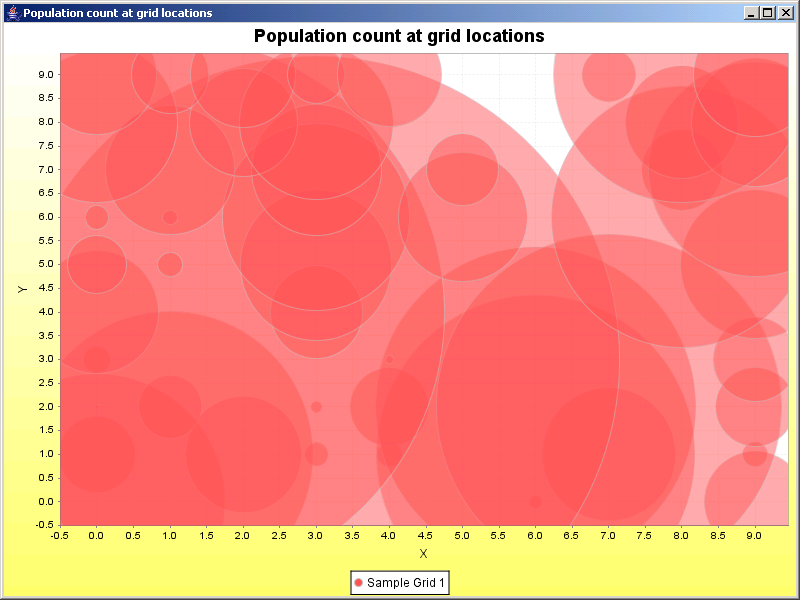Java Is Open Source Programming Language You Can Download From Java and Java Libraries From http://www.oracle.com.
We provide this code related to title for you to solve your developing problem easily. Libraries which is import in this program you can download from http://www.oracle.com.
JFreeChart: Bubbly Bubbles Demo 2

/* ===========================================================
* JFreeChart : a free chart library for the Java(tm) platform
* ===========================================================
*
* (C) Copyright 2000-2004, by Object Refinery Limited and Contributors.
*
* Project Info: http://www.jfree.org/jfreechart/index.html
*
* This library is free software; you can redistribute it and/or modify it under the terms
* of the GNU Lesser General Public License as published by the Free Software Foundation;
* either version 2.1 of the License, or (at your option) any later version.
*
* This library is distributed in the hope that it will be useful, but WITHOUT ANY WARRANTY;
* without even the implied warranty of MERCHANTABILITY or FITNESS FOR A PARTICULAR PURPOSE.
* See the GNU Lesser General Public License for more details.
*
* You should have received a copy of the GNU Lesser General Public License along with this
* library; if not, write to the Free Software Foundation, Inc., 59 Temple Place, Suite 330,
* Boston, MA 02111-1307, USA.
*
* [Java is a trademark or registered trademark of Sun Microsystems, Inc.
* in the United States and other countries.]
*
* -----------------------
* BubblyBubblesDemo2.java
* -----------------------
* (C) Copyright 2003, 2004, by Barak Naveh and Contributors.
*
* Original Author: Barak Naveh;;
* Contributor(s): David Gilbert (for Object Refinery Limited);
*
* $Id: BubblyBubblesDemo2.java,v 1.12 2004/04/26 19:11:53 taqua Exp $
*
* Changes
* -------
* 10-Jul-2003 : Version 1 contributed by Barak Naveh (DG);
* 29-Mar-2004 : Elimintated compiler warnings while keeping JFreeChart conventions (BN);
*
*/
package org.jfree.chart.demo;
import java.awt.Color;
import java.awt.GradientPaint;
import org.jfree.chart.ChartFactory;
import org.jfree.chart.ChartPanel;
import org.jfree.chart.JFreeChart;
import org.jfree.chart.axis.NumberAxis;
import org.jfree.chart.plot.PlotOrientation;
import org.jfree.chart.plot.XYPlot;
import org.jfree.data.xy.MatrixSeriesCollection;
import org.jfree.data.xy.NormalizedMatrixSeries;
import org.jfree.ui.ApplicationFrame;
import org.jfree.ui.RefineryUtilities;
/**
* A demo that shows how matrix series can be used for charts that follow a
* constantly changing grid input.
*
* @author Barak Naveh
*
* @since Jun 25, 2003
*/
public class BubblyBubblesDemo2 extends ApplicationFrame {
/** The default size. */
private static final int SIZE = 10;
/** The default title. */
private static final String TITLE = "Population count at grid locations";
/**
* The normalized matrix series is used here to represent a changing
* population on a grid.
*/
NormalizedMatrixSeries series;
/**
* A demonstration application showing a bubble chart using matrix series.
*
* @param title the frame title.
*/
public BubblyBubblesDemo2(final String title) {
super(title);
this.series = createInitialSeries();
final MatrixSeriesCollection dataset = new MatrixSeriesCollection(this.series);
final JFreeChart chart = ChartFactory.createBubbleChart(
TITLE,
"X",
"Y",
dataset,
PlotOrientation.VERTICAL,
true,
true,
false
);
chart.setBackgroundPaint(new GradientPaint(0, 0, Color.white, 0, 1000, Color.yellow));
final XYPlot plot = chart.getXYPlot();
plot.setForegroundAlpha(0.5f);
final NumberAxis domainAxis = (NumberAxis) plot.getDomainAxis();
domainAxis.setLowerBound(-0.5);
final NumberAxis rangeAxis = (NumberAxis) plot.getRangeAxis();
rangeAxis.setLowerBound(-0.5);
final ChartPanel chartPanel = new ChartPanel(chart);
// chartPanel.setVerticalZoom(true);
// chartPanel.setHorizontalZoom(true);
setContentPane(chartPanel);
}
// ****************************************************************************
// * JFREECHART DEVELOPER GUIDE *
// * The JFreeChart Developer Guide, written by David Gilbert, is available *
// * to purchase from Object Refinery Limited: *
// * *
// * http://www.object-refinery.com/jfreechart/guide.html *
// * *
// * Sales are used to provide funding for the JFreeChart project - please *
// * support us so that we can continue developing free software. *
// ****************************************************************************
/**
* Starting point for the demonstration application.
*
* @param args ignored.
*/
public static void main(final String[] args) {
final BubblyBubblesDemo2 demo = new BubblyBubblesDemo2(TITLE);
demo.pack();
demo.setSize(800, 600);
RefineryUtilities.centerFrameOnScreen(demo);
demo.setVisible(true);
final Thread updater = demo.new UpdaterThread();
updater.setDaemon(true);
updater.start();
}
/**
* Creates a series.
*
* @return The series.
*/
private NormalizedMatrixSeries createInitialSeries() {
final NormalizedMatrixSeries newSeries =
new NormalizedMatrixSeries("Sample Grid 1", SIZE, SIZE);
// seed a few random bubbles
for (int count = 0; count < SIZE * 3; count++) {
final int i = (int) (Math.random() * SIZE);
final int j = (int) (Math.random() * SIZE);
final double mij = Math.random() * 1;
newSeries.update(i, j, mij);
}
newSeries.setScaleFactor(newSeries.getItemCount());
return newSeries;
}
/**
* Updater thread.
*/
private class UpdaterThread extends Thread {
/**
* @see java.lang.Runnable#run()
*/
public void run() {
setPriority(MIN_PRIORITY); // be nice
while (true) {
final int i = (int) (Math.random() * SIZE);
final int j = (int) (Math.random() * SIZE);
final double change = Math.random() * 3.0 - 1.0;
series.update(i, j, series.get(i, j) + change);
try {
sleep(50);
}
catch (InterruptedException e) {
// suppressed
}
}
}
}
}